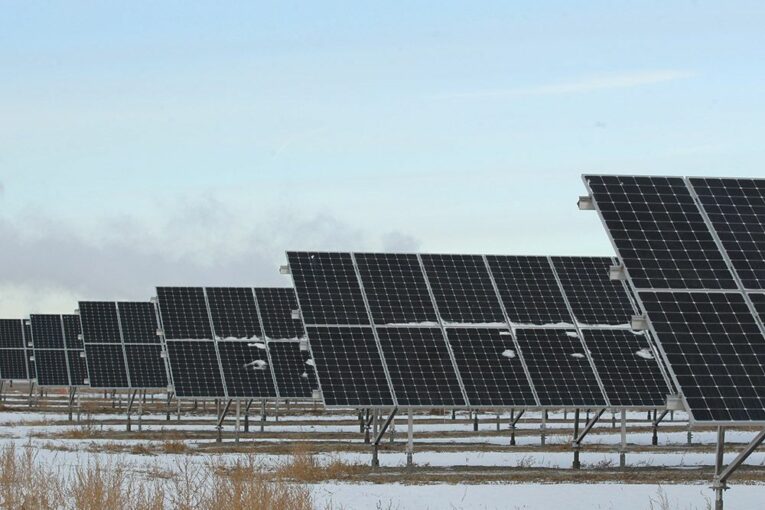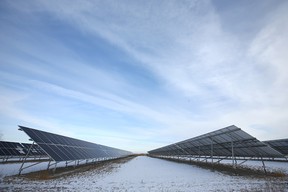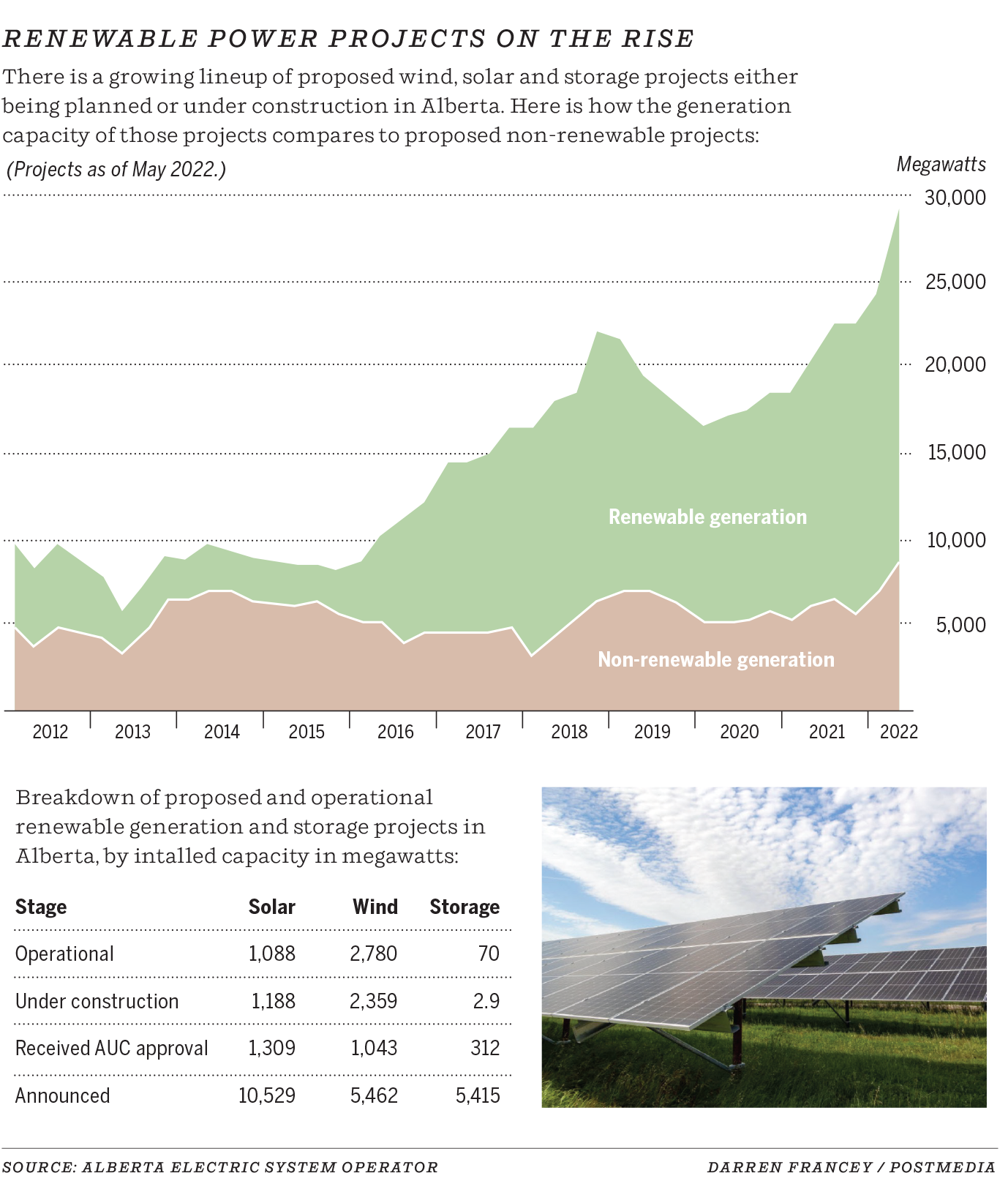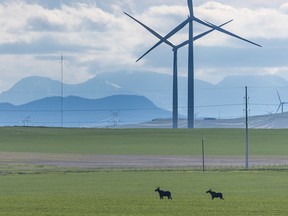
[ad_1]
Every few weeks, it seems another renewable power project is rolled out in Alberta.
Earlier this month, pipeline giant TC Energy announced an 81-megawatt solar development near Aldersyde, which also comes with a battery storage system. The Calgary-based company has broken ground on the Saddlebrook Solar Project and construction on the $146-million development should wrap up by the end of 2023.
Saddlebrook joins a growing lineup of renewable projects in the provincial queue — developments that are being built, are moving through the regulatory process or have been proposed, from a smaller-scale solar initiative near Spruce Grove to a large wind farm pitched for the Pincher Creek area.
“In short, customers — industrial customers especially — are demanding from the marketplace cleaner energy,” TC Energy vice-president Omar Khayum in an interview.
“We see strong customer demand for greater utilization of wind and solar in the province, and certainly across Canada.”
Alberta has become one of the hottest spots in the country for wind and solar in recent years.
A report last year by the Canada Energy Regulator said the share of renewables in the province’s generation capacity mix was expected to jump to 26 per cent by next year from 16 per cent in 2017.
More than $4.3 billion worth of renewable projects have been announced in Alberta since 2019, according to provincial data.
And the list keeps growing.

As part of a new report to be released next week, the Alberta Electric System Operator (AESO) indicates 14,000 megawatts of installed solar capacity and 11,600 MW of wind — along with 5,800 MW of storage — are either under construction, have received approval or been announced by proponents.
“You get cycles of development that happen,” said Miranda Keating Erickson, vice-president of markets at AESO, which manages the province’s power grid.
“There is a rush in Alberta right now because there’s lots of opportunity and companies are wanting to get their foot in the door first — because at some point, there is sort of a natural limit.”
Recommended from Editorial
-

Alberta made estimated $160M from Renewable Energy Program as power prices surged: U of C report
-

Varcoe: Renewable energy gains traction in Alberta, amid strong backing for oil and gas
-

TC Energy spending $146 million to build solar power project in Alberta
-

Solar panels atop Chinook Centre able to feed into power grid
This upturn comes in the wake of a new report showing the province’s former Renewable Electricity Program, introduced by the NDP government in 2016 and later cancelled by the UCP, not only kick-started wind projects and brought new players into Alberta, but made money for the treasury.
The study by the University of Calgary’s School of Public Policy said the program has led to about $100 million in payments to the province and saved another $60 million in surrendered carbon offsets.

As the country moves to a net-zero emitting electricity system by 2035, experts believe the province’s surge in renewable energy projects will continue.
“In Alberta, we are seeing unprecedented growth for renewables and it’s the place where renewables are growing the most in all of Canada,” said Binnu Jeyakumar, director of electricity at the Pembina Institute.
“We have great wind and solar resources and it’s actually very cost-effective in Alberta.”
Jeyakumar credits the REP program for leading to “price discovery” and demonstrating how cost-competitive renewable projects can be in the province. Alberta’s deregulated market structure has since attracted increased investment.
Much of the recent success in wind and solar development involves companies striking partnerships with project developers to buy green power and the associated renewable energy credits in Alberta.
This trend has led to about $4 billion in projects being developed, Jeyakumar said. Companies such as Amazon, Scotiabank and Microsoft are among some of the largest corporate buyers inking such Power Purchase Agreements (PPAs) in the province.
The capital investment represents about 5,000 jobs, an estimated $10 million in annual municipal taxes (paid by developers) and about $10 million in lease payments to landowners, she noted.
Alberta’s deregulated power market is the only jurisdiction in the country that easily allows such corporate power partnerships.
Aside from building its own solar development, Calgary-based TC Energy has acquired more than 400 MW of renewable power through such PPAs in Alberta over the past two years, including last year’s announcement to acquire all of the output from the 297-megawatt Sharp Hills Wind Farm in southeast Alberta.
“We are taking an all-of-the-above approach,” said Khayum. “We can partner with others and enable them to develop renewables. We can also develop our own renewables in parallel.”
The Business Renewables Centre Canada, which tracks corporate procurement of renewable energy projects in Canada, identified 151 MW of such power purchase agreements involving corporate buyers in 2020, which soared to more than 1,260 MW last year.

During the first six months of this year, another 433 MW in such partnerships were announced, according to the centre’s online deal-tracker.
Renewable projects have been picking up steam as companies strive to reduce their own emissions and respond to ESG concerns from investors.
“The long-term contracts also allow buyers to avoid the (volatile power) market prices,” added Evan Wilson with the Canadian Renewable Energy Association.
Industry experts anticipate more corporate deals will be signed and projects built in the coming years, although some proposals will fall by the wayside.
The AESO says the total installed generation capacity in the province today is almost 17,500 MW, with solar making up 1,088 MW, wind at 2,780 MW, and hydro developments adding almost 900 MW.
In an AESO presentation from May, the grid operator noted the REP program led to a “steep increase” in generation applications from 2016 until 2018, and a slowdown after it was cancelled.
The volume of applications has increased significantly since 2020 to a record high, “and this trend is expected to continue.”
“You get this perfect storm where everybody comes to Alberta, and Alberta is the place to be. But I think we’ve also seen through time that there is only some portion of those projects that will actually move ahead,” added Keating Erickson.
“Definitely, our amount of renewables connected on the system has been growing — and they’ve been growing quickly.”
Chris Varcoe is a Calgary Herald columnist.
[ad_2]
You can read more of the news on source
